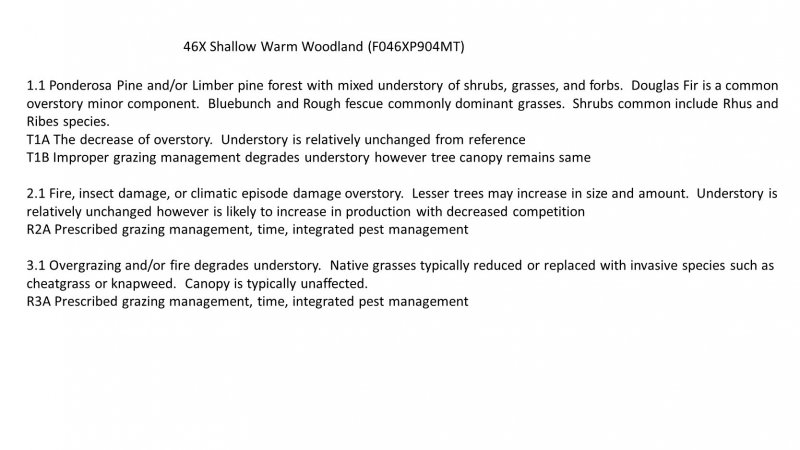
Natural Resources
Conservation Service
Ecological site F046XP904MT
Shallow Warm Woodland Group
Last updated: 9/07/2023
Accessed: 12/21/2025
General information
Provisional. A provisional ecological site description has undergone quality control and quality assurance review. It contains a working state and transition model and enough information to identify the ecological site.
MLRA notes
Major Land Resource Area (MLRA): 046X–Northern and Central Rocky Mountain Foothills
The Provisional ESD Initiative was established to expedite the development of ecological site descriptions through the development of provisional ESDs. While Provisional ESDs are not complete, the intent is to produce an ESD complete enough for land managers to use while approved ESDs are being developed. This project area has mixed ownership falling primarily under private ownership or lands managed by the Blackfeet Nation.
This PES project is contained within MLRA 46. Major Land Resource Area (MLRA) 46, Rocky Mountain Foothills, is approximately 11.6 million acres. MLRA 46’s extent has changed over recent years and is now primarily located in Montana and Wyoming with limited acres in Utah and Colorado. It spans from the Canadian border south to the Uinta Mountains of Northwest Colorado. MLRA 46 is a transitional MLRA between the plains and mountains of primarily non-forested rangeland. In Montana, 3 LRUs exist based on differences in geology, landscape, soils, water resources, and plant communities. Elevations for this MLRA in Montana vary from a low of 3200 to 6500 feet (975 to 1981 m) however the elevations on the fringes of this MLRA may fall outside of that range in extremely small isolated areas where the boundaries between LRU C and MLRA 43B LRU G are not easily defined. Annual precipitation ranges from 8 inches (254 mm) to, in very isolated areas, 42 inches (1083 mm). In general precipitation rarely exceeds 24 inches (610 mm). Frost Free Days are variable from 50 days near the Crazy and Beartooth Mountains to 130 days in the foothills south of the Bear’s Paw Mtns of Central Montana. The geology of MLRA 46 is generally Cretaceous and Jurassic marine sediments
MLRA 46’s plant communities are dominated by cool season bunchgrasses with mixed shrubs. This MLRA is rarely forested however Ponderosa and Limber pine do occupy areas. Portions of this MRLA may have a sub dominance of warm season mid-statured bunchgrasses like Little bluestem, however the general concept of the MLRA does not have a large component of warm season species. Wyoming big sagebrush, Mountain big sagebrush, Silver sagebrush, and Shrubby cinquefoil tend to be the dominant shrub component. The kind and presences of shrubs tends to be driven by a combination of soils and climate. Due to the variable nature of the Land Resources Units, Climatic subsets will be necessary to describe the ecological sites and the variation of plant communities for this MLRA.
Elevations of this landscape is from 3221 feet (982 m) to 6954 feet (2120 m). Well drained soils are dominate in this MLRA. Most areas have 0 to 15 percent slope, while some are 15 to 30 percent mostly on the 43B boundary. Soils are Slight to Moderate Alkaline, except for small area next to mountains. Mean clay percentages are mostly above 23 percent. Primarily very deep soils 70 percent, moderately-deep and deep soils 30 percent.
The climate of MLRA 46 averages 16.9 inches (429 mm) though the Rocky Mountain Foothills receive 10 inches (247 mm) to 42 inches (1083 mm) annually. The average air temperature ranges from 36 degrees F (2.39 degrees C) to 46 degrees F (8.02 degrees C). The soil temperature regime is frigid with a soil moisture regime dominated by Ustic with areas of Udic. Frost free days is from 50 to 110 days.
The vegetation potential for the Rocky Mountain Front Foothills can be variable but is dominated by rangeland. Forested extents are typically minimal and consist primarily of Limber Pine, Ponderosa Pine, and Rocky Mountain Juniper with mixed grassland. The rangelands of this MLRA are variable. The dryer sites are dominated by bluebunch wheatgrass and as the precipitation increases and temperatures decrease rough fescue increases. In areas that receive the highest precipitation, Richardson’s needlegrass may exist. Shrub cover is limited in this area and is generally silver sagebrush and shrubby cinquefoil with areas of chokecherry and buffaloberry (both Russet and Silver). The glacial drift areas will often have wetland associated vegetation as well as large areas of Quaking aspen.
Ecological site concept
• Dominant Cover: Coniferous Forest
• Site does not receive any additional water
• Soils are
o Not saline or saline-sodic
o Not strongly or violently effervescent within surface mineral 4”
o Soil is shallow (less than 20in (50cm) to bedrock, lithic, or paralithic root restriction)
o Soil is not ashy or medial textural family
o Stones and/or boulders cover <15% surface area or fragmental textural class
• Soil surface texture variable
• Site Landform: hillslopes, buttes, escarpments
• Transitional area of foothills separating plains and mountains
• Parent material is residuum and colluvium
• Moisture Regime: ustic
• Temperature Regime: frigid
• Elevation Range: 3800-5800
• Slope: 0-60% (typically less than 25%)
Associated sites
| F046XP911MT |
Upland Warm Woodland Group The Upland Warm Woodland exists on similar landforms however tends to occupy landscape positions below the Shallow Warm Woodland sites where deeper soils exist. |
|---|
Similar sites
| F046XP911MT |
Upland Warm Woodland Group The Upland Warm Woodland follows a similar STM and expresses a similar plant community though is more productive and tends to be more resilient |
|---|
Table 1. Dominant plant species
| Tree |
(1) Pinus ponderosa var. scopulorum |
|---|---|
| Shrub |
(1) Symphoricarpos |
| Herbaceous |
(1) Pseudoroegneria spicata |
Click on box and path labels to scroll to the respective text.

